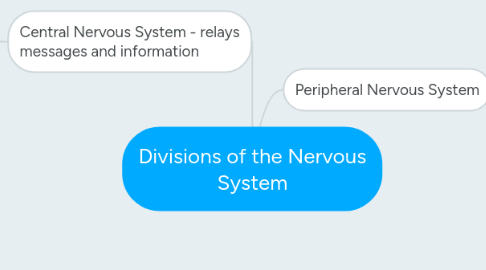
1. Central Nervous System - relays messages and information
1.1. Brain - where impulses flow and originate
1.1.1. Cerebrum - Largest part of brain; controls voluntary activities
1.1.1.1. Frontal Lobe - voluntary movement, intellect, learning,recall, judgement, reasoning, planning,and personality
1.1.1.2. Parietal Lobe - perception of stimuli
1.1.1.3. Occipital Lobe - vision
1.1.1.4. Temporal Lobe - perception and recollection of auditory stimuli, taste, and smell
1.1.2. Cerebellum - second largest region of brain; coordinates and balances muscle action
1.1.3. Brain Stem - connects brain and spinal cord
1.1.4. Thalamus - receives information and passes it to the proper places
1.1.5. Hypothalamus - recognition of hunger, thirst, anger, etc.
1.2. Spinal Cord - maintain communication between brain and rest of body
2. Peripheral Nervous System
2.1. Sensory Division - transmits impulses from sense organs to CNS
2.2. Motor Division - transmits impulses from CNS to muscles or glands
2.2.1. Somatic Division - regulates activities under concious control
2.2.2. Autonomic Division - regulates involuntary activity
2.2.2.1. Sympathetic Nervous System - fight or flight
2.2.2.2. Parasympathetic Nervous System - rest and digest
